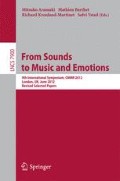Abstract
Fugue analysis is a challenging problem. We propose an algorithm that detects subjects and counter-subjects in a symbolic score where all the voices are separated, determining the precise ends and the occurrence positions of these patterns. The algorithm is based on a diatonic similarity between pitch intervals combined with a strict length matching for all notes, except for the first and the last one. On the 24 fugues of the first book of Bach’s Well-Tempered Clavier, the algorithm predicts 66% of the subjects with a musically relevant end, and finally retrieves 85% of the subject occurrences, with almost no false positive.
Access this chapter
Tax calculation will be finalised at checkout
Purchases are for personal use only
Preview
Unable to display preview. Download preview PDF.
References
24 Jewels, http://www.earsense.org/Earsense/WTC/Shostakovich
Browles, L.: Creating a tool to analyse contrapuntal music. Bachelor Dissertation, Univ. of Bristol (2005)
Bruhn, S.: J. S. Bach’s Well-Tempered Clavier. In-depth Analysis and Interpretation (1993) iSBN 962-580-017-4, 962-580-018-2, 962-580-019-0, 962-580-020-4, http://www-personal.umich.edu/~siglind/text.htm
Bruhn, S.: J. S. Bachs Wohltemperiertes Klavier, Analyse und Gestaltung. Edition Gorz (2006) iSBN 3-938095-05-9
Cambouropoulos, E.: A general pitch interval representation: Theory and applications. Journal of New Music Research 25(3), 231–251 (1996)
Cambouropoulos, E., Crochemore, M., Iliopoulos, C.S., Mohamed, M., Sagot, M.F.: A pattern extraction algorithm for abstract melodic representations that allow partial overlapping of intervallic categories. In: Int. Society for Music Information Retrieval Conf. (ISMIR 2005), pp. 167–174 (2005)
Cambouropoulos, E., Tsougras, C.: Influence of musical similarity on melodic segmentation: Representations and algorithms. In: Sound and Music Computing, SMC 2004 (2004)
Charlier, C.: Pour une lecture alternative du Clavier bien tempéré. Jacquart (2009)
Clifford, R., Iliopoulos, C.S.: Approximate string matching for music analysis. Soft. Comput. 8(9), 597–603 (2004)
Crawford, T., Iliopoulos, C., Raman, R.: String matching techniques for musical similarity and melodic recognition. Computing in Musicology 11, 71–100 (1998)
Ghias, A., Logan, J., Chamberlin, D., Smith, B.C.: Query by humming: musical information retrieval in an audio database. In: ACM Multimedia, pp. 231–236 (1995)
Giraud, M., Groult, R., Levé, F.: Detecting Episodes with Harmonic Sequences for Fugue Analysis. In: Int. Symp. for Music Information Retrieval, ISMIR 2012 (2012)
Hakenberg, J.: The Pirate Fugues, http://www.hakenberg.de/music/music.htm
Hewlett, W.B.: A base-40 number-line representation of musical pitch notation. Musikometrika 4(1-14) (1992)
Hiraga, Y.: Structural recognition of music by pattern matching. In: Int. Computer Music Conference (ICMC 1997), pp. 426–429 (1997)
Hsu, J.L., Liu, C.C., Chen, A.: Efficient repeating pattern finding in music databases. In: Int. Conference on Information and Knowledge Management, CIKM 1998 (1998)
Karydis, I., Nanopoulos, A., Manolopoulos, Y.: Finding maximum-length repeating patterns in music databases. Multimedia Tools Appl. 32, 49–71 (2007)
Lemström, K., Laine, P.: Musical information retrieval using musical parameters. In: Int. Computer Music Conference (ICMC 1998), pp. 341–348 (1998)
Liu, C.C., Hsu, J.L., Chen, A.L.: Efficient theme and non-trivial repeating pattern discovering in music databases. In: Int. Conf. on Data Engineering (ICDE 1999), pp. 14–21 (1999)
Lung Lo, Y., Yu Chen, C.: Fault tolerant non-trivial repeating pattern discovering for music data. In: Int. Workshop on Component-Based Software Engineering, Software Architecture and Reuse (ICIS-COMSAR 2006), pp. 130–135 (2006)
Meek, C., Birmingham, W.P.: Automatic thematic extractor. Journal of Intelligent Information Systems 21(1), 9–33 (2003)
Meredith, D.: Pitch spelling algorithms. In: 5th Triennal ESOM Conference, pp. 204–207 (2003)
Mongeau, M., Sankoff, D.: Comparaison of musical sequences. Computer and the Humanities 24, 161–175 (1990)
Orpen, K.S., Huron, D.: Measurement of similarity in music: A quantitative approach for non-parametric representations. Computers in Music Research 4, 1–44 (1992)
Perttu, S.: Combinatorial pattern matching in musical sequences. Master Thesis, University of Helsinki (2000)
Plutalov, D.V.: Dmitry Shostakovich’s Twenty-Four Preludes and Fugues op. 87: An Analysis and Critical Evaluation of the Printed Edition Based on the Composer’s Recorded Performance. Ph.D. thesis, University of Nebraska (2010)
Prout, E.: Analysis of J.S. Bach’s forty-eight fugues (Das Wohltemperierte Clavier). E. Ashdown, London (1910)
Rafailidis, D., Nanopoulos, A., Manolopoulos, Y., Cambouropoulos, E.: Detection of stream segments in symbolic musical data. In: Int. Society for Music Information Retrieval Conf. (ISMIR 2008), pp. 83–88 (2008)
Smith, L., Medina, R.: Discovering themes by exact pattern matching. In: Int. Symp. for Music Information Retrieval (ISMIR 2001), pp. 31–32 (2001)
Weng, P.H., Chen, A.L.P.: Automatic musical form analysis. In: Int. Conference on Digital Archive Technologies, ICDAT 2005 (2005)
Author information
Authors and Affiliations
Editor information
Editors and Affiliations
Rights and permissions
Copyright information
© 2013 Springer-Verlag Berlin Heidelberg
About this paper
Cite this paper
Giraud, M., Groult, R., Levé, F. (2013). Subject and Counter-Subject Detection for Analysis of the Well-Tempered Clavier Fugues. In: Aramaki, M., Barthet, M., Kronland-Martinet, R., Ystad, S. (eds) From Sounds to Music and Emotions. CMMR 2012. Lecture Notes in Computer Science, vol 7900. Springer, Berlin, Heidelberg. https://doi.org/10.1007/978-3-642-41248-6_24
Download citation
DOI: https://doi.org/10.1007/978-3-642-41248-6_24
Publisher Name: Springer, Berlin, Heidelberg
Print ISBN: 978-3-642-41247-9
Online ISBN: 978-3-642-41248-6
eBook Packages: Computer ScienceComputer Science (R0)

